At present, the social economy is entering the information age represented by computer, communication technology and network technology as the core, and the continuous development of modern information technology will certainly have a great impact on the teaching mode, content and methods of traditional accounting computerization. We aim to improve the existing higher vocational accounting teaching mode by building a multi-integrated teaching mode through federated learning based on 5G communication network as an environment for efficient information transfer. In addition, we develop a joint optimization strategy for priority-dependent task offloading, wireless bandwidth, and computational power in a distributed machine learning approach to ensure that more resources are allocated to users with higher priority while protecting user data privacy and reducing learning overhead. We have conducted extensive simulation experiments for both environments, and these simulation results demonstrate the effectiveness of our proposed solutions for different problems from different perspectives.
Over the years of national development of higher vocational education, higher vocational education has played a very important role in promoting China’s social and economic development, and has trained a large number of front-line talents for China’s economic development and various enterprises and institutions [1]. With the deepening of China’s reform and opening-up and the rapid development of economy, the role of China’s higher vocational education in talent training will be even greater [2]. On the other hand, although governments at all levels have actively developed higher vocational education by adjusting and reorganizing educational resources and taking various measures, the higher vocational education in China has grown greatly in recent years in terms of the number of schools and enrollment, but it has not really become the main force of higher education, and the social reputation of higher vocational education and the recognition of higher vocational education by students and parents are far from ideal [3].
The development of social economy needs to accelerate the development of vocational education and create hundreds of millions of high-quality workers, but compared with the needs of society, the development of vocational education in China is still lagging behind and there are many problems [4]. The layout of the professional structure of higher vocational education has not been separated from the system of discipline teaching, which affects the characteristics of higher vocational education, and the setting of curriculum also lacks the characteristics of higher vocational education. The compressed model is not suitable for cultivating technically skilled talents. As for teaching materials, most of the higher vocational teaching materials are still compressed from undergraduate teaching materials or written by temporary organizations, which seriously lags behind the development of higher vocational education [5,6].
These problems restrict the healthy development of higher vocational education and affect the cultivation of high quality workers. With the rapid development of private economy, the demand for front-line accounting professionals is increasing, but the talents cultivated by higher vocational accounting majors cannot meet the needs of the market. At present, there are more and more researches on the curriculum of higher vocational education, and some experts have made a lot of achievements through their unremitting efforts. In this paper, we have made use of the results of the research on vocational education curriculum at home and abroad to overcome and solve the shortcomings in the curriculum setting of accounting informatization system for accounting majors in higher vocational education, to improve the teaching quality, and to cultivate accounting informatization talents to meet the needs of society[7,8]. We start from two aspects, 5G communication and federated learning, to build the cascade approach. In this paper, we formulate priority-dependent task offloading as well as bandwidth and computational power allocation strategies in a distributed machine learning manner, so as to ensure that users with high priority are allocated more resources while protecting user data privacy and reducing learning overhead. Ultimately, our content-centric network-based 5G mobile communication network architecture with efficient federated learning provides an efficient technology-enabled platform for teaching accounting informatics in higher education institutions [9,10].
In order to meet the challenges posed by 5G application requirements and technology scenarios, 5G networks require technical innovations in both the underlying network platform and network architecture [11]. The current communication infrastructure network platform is based on dedicated hardware, and the 5G network will be designed and implemented based on general-purpose hardware through the introduction of Internet and Network Function Virtualization (NFV) technologies to solve the problems of high cost, poor compatibility, weak dynamic allocation of resources, and long service deployment cycles [12]. The 5G architecture based on the content-centric network is shown in Figure 1.
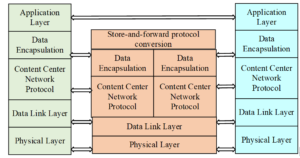
The specific communication process in the packet domain of the content-centric network-based 5G architecture is shown in Figure 2. Since the data transmission process at other layers, such as the application layer and data link layer, is consistent with that of IP networks, the data transmission process at the network layer is mainly described below.
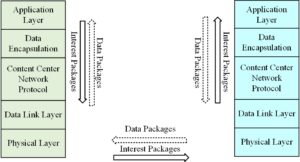
With the development of technology and economy, IIoT devices have a certain amount of computational power to process some tasks and make decisions. In addition, this paper assumes that the CAPs work in parallel, and each CAP can process tasks in parallel. Also, we assume that the tasks of each IIoT device are not dependent, so the tasks can be partitioned into arbitrary sizes. Accordingly, each IIoT device can flexibly allocate the proportion of tasks computed locally and in the CAP within each time slot, which are denoted as \(\alpha _k^0\) and \(\alpha _k^m\) , respectively, as follows.see Figure 3.
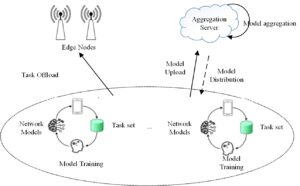
\[\label{e1} \alpha _k^0 + \sum\limits_{m = 1}^M {\alpha _k^m} = 1. \tag{1}\]
Figure 4 depicts the main process of federation learning, where all IIoT devices upload their model parameters to the central node responsible for model aggregation after they have trained the corresponding rounds. The model aggregation process at the time slot can be formulated as
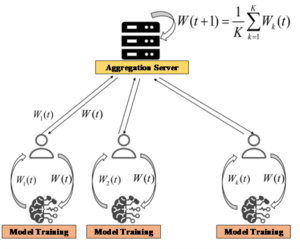
\[\label{e2} W(\tau + 1) = \frac{1}{K}\sum\limits_{k = 1}^K {{W_k}(\tau )}, \tag{2}\] where \(W(\tau + 1)\) represents the aggregated parameter matrix of the evaluation network after time slot \(\tau\) . After the model aggregation, the central server will distribute the aggregated parameters to each IIoT device. The model distribution process after \((\tau + 1)\) time slots can be expressed as
\[\label{e3} {W_k}(\tau + \widehat e) = W(\tau + \widehat e). \tag{3}\]
After the evaluation network parameter matrix is updated for each IIoT device, the system repeats the above three steps until the system performance converges.
The experiment is deployed on ndnSIM 2.0, a content-centric network communication simulation platform based on NS-3. The tracing assistant ndn: App Delay Tracer in ndnSIM 2.0 is used to trace the transmission of Interest and Data packets, and the experiment results are recorded in the text file app-delays-trace. txt. The data in the text file shows that the data requester node 0 has the smallest end-to-end transmission delay of 20µs because it is directly connected to the data provider node 1. node 20 is 3 route hops away from node 1 and has an end-to-end transmission delay of 90µs. node 5 and node 8 are also 3 route hops away from node 1, but due to the web caching capability of the content center network, and node 0 also requests the same internal packets. The end-to-end transmission delay of node 5 and node 8 is the same and less than the end-to-end transmission delay of node 20, which is 60µs. The end-to-end transmission delay between node 24 and node 1 is 0.1ms for a distance of 4 routing hops [13,14]. Although the end-to-end transmission delay in the network increases with the number of routing hops, the transmission delay can be significantly reduced due to the network caching feature of the content centric network. In addition, even in the worst case scenario, where there is no requested data cached in the network, the content-centric network-based 5G architecture allows far more data to be routed through the network than the IP network, as extrapolated from previous experimental data. In summary, the content-centric network-based 5G architecture is fully capable of meeting the technical requirements for low latency and high reliability of future 5G networks, and has great room for improvement in network performance [15]. Therefore, the experimental data of the first crossover switch is only analyzed in this paper. The sequence number of Data packets received by node 5 during the switching process is shown in Figure 5.
The data requester sends a new Interest request along with the retransmitted Interest request. Therefore, as shown in Figure 5, the packet sequence number fluctuates between 1.300070s and 1.700700s, when the transmission process of the communication link is disturbed until 1.700130s when the communication returns to normal. In summary, after the communication link is re-established due to the interruption of the out-of-area switching, the transmission process of Data packets (1.300000s to 1.700130s) is disturbed and the communication link is completely restored to normal at 1.700130s. Therefore, the interference time of the content-centric network-based 5G architecture is 400 ms under high-speed mobile conditions, which is much lower than the 800 ms required for GSM-R systems, thus demonstrating the good mobile performance of the content-centric network-based 5G architecture.

Based on the experimental data in the app-delays-trace.txt text file, a line graph of the packet sequence number over time can be plotted, and the results of the first link outage are shown in Figure 6. The results of the two subsequent link interruptions are the same as the first one.

The experimental results show that the sequence number of Data packets received by node (6) before the link is interrupted varies linearly, which means that the data transmission is not interfered. The node (6) received 9 Data packets at 0.968833s and sent Interest packets to the server in sequence between 0.968833s and 1.000000s, and the server returned the corresponding Data packets one after another after receiving the request. When the link is interrupted at 1.000000s, the transmission is interrupted and the requested Data packets are cached in the network due to the network caching function of the content center network. When the connection between node (2) and node (6) is re-established at 1.300000s, node (6) receives Data packets 10, 13, 14, 11 and 12, indicating that the link is interfered during the transmission of Data packets 11, 12, 13 and 14 (1.468833s to 1.768833s), and finally the data transmission of the link is completely restored at 1.868833s. The data transmission of the link is completely restored to normal at 1.868833s. By analyzing the experimental results, the transmission interference time of the content center network is 400ms, which is a significant advantage compared to the QoS metrics specified by the GSM-R system. In order to compare the transmission interference time of the two systems, a bar chart is used as shown in Figure 7. Where 1 represents the content-centric network and 2 represents the GSM-R system based on the TCP/IP protocol. The caching mechanism of the content-centric network speeds up the data transmission rate, increases the utilization of network resources, and greatly increases the reliability of communication.

From these trends, it is clear that the federal framework in this paper can achieve centralized results at the system level and protect data privacy with only a small loss of convergence speed.

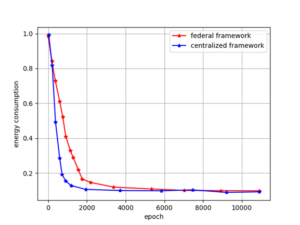
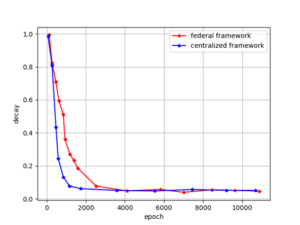
Figure 8,Figure 9 and Figure 10 illustrate the system performance of the federation framework and the traditional centralized framework, where the number of CAP and IIoT devices corresponding to the plots are set to 2 and 5, respectively. In particular, the performance of the federal framework in both plots converges roughly at the 4000th and 3000th training rounds, while the performance of the traditional centralized framework in both plots converges roughly at the 2000th training round. From these trends, it is clear that the federal framework in this paper can achieve centralized performance in terms of energy consumption and latency with only a small loss of convergence speed and protect data privacy, respectively.
Figure 11 illustrates the impact of \(\lambda\)on the total system cost for the federal and traditional centralized frameworks, where this figure corresponds to the number of IIoT devices and CAPs of 2 and 5, respectively, and the value of \(\lambda\) varies from 0.1 to 0.9. In addition, the weighted cost varies from 0 to 0.09.

We propose a 5G network architecture based on the content-centric network, and study the communication performance of the 5G architecture based on the content-centric network based on the core capability indexes required by the future 5G network, and conduct simulation experiments on the performance indexes such as user experience rate, end-to-end transmission delay and mobility. We further propose a high-speed railroad communication architecture based on content-centric network, and verify the performance advantages of content-centric network in high-speed mobile environment by simulation experiments in detail. The experiments show that the new network architecture based on the content-centric network has excellent mobile communication performance and can better meet the future 5G mobile communication requirements.
The authors declared that they have no conflicts of interest regarding this work.
Harlow, A.N., Buswell, N.T., Lo, S.M. and Sato, B.K., 2022. Stakeholder perspectives on hiring teaching-focused faculty at research-intensive universities. International Journal of STEM Education, 9(1), p.54.
1970-2025 CP (Manitoba, Canada) unless otherwise stated.